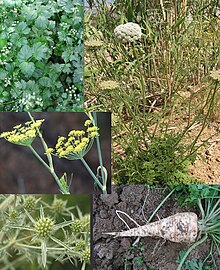Umbellifer
| Carrot family | |
|---|---|
 |
|
| Umbelliferae: Apium leaves and tiny inflorescences, Daucus habit, Foeniculum inflorescences, Eryngium inflorescences, Petroselinum root. | |
| Scientific classification | |
| Kingdom: | Plantae |
| Clade: | Angiosperms |
| Clade: | Eudicots |
| Clade: | Asterids |
| Order: | Apiales |
| Family: |
Apiaceae Lindl. |
| Type genus | |
|
Apium L. |
|
| Subfamilies | |
|
|
| Synonyms | |
|
Umbelliferae |
|
Umbelliferae
Apiaceae or Umbelliferae, is a family of mostly aromatic flowering plants named after the type genus Apium and commonly known as the celery, carrot or parsley family. It is the 16th-largest family of flowering plants, with more than 3,700 species in 434 genera including such well-known and economically important plants such as angelica, anise, asafoetida, caraway, carrot, celery, chervil, coriander, cumin, dill, fennel, hemlock, lovage, cow parsley, parsley, parsnip, sea holly, giant hogweed and silphium (a plant whose identity is unclear and which may be extinct).
Most Apiaceae are annual, biennial or perennial herbs (frequently with the leaves aggregated toward the base), though a minority are woody shrubs or small trees such as Bupleurum fruticosum. Their leaves are of variable size and alternately arranged, or with the upper leaves becoming nearly opposite. The leaves may be petiolate or sessile. There are no stipules but the petioles are frequently sheathing and the leaves may be perfoliate. The leaf blade is usually dissected, ternate or pinnatifid, but simple and entire in some genera, e.g. Bupleurum. Commonly, their leaves emit a marked smell when crushed, aromatic to foetid, but absent in some species.
...
Wikipedia
